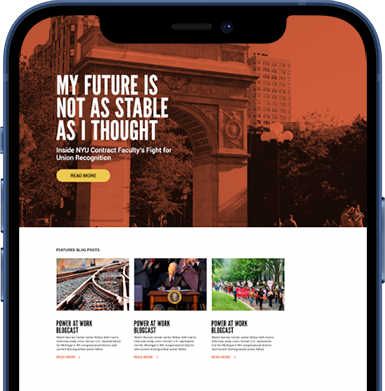He didn’t say it in quite this way, but the dominant theme of President Biden’s State of the Union Address might have been cribbed from an old labor anthem: which side are you on? President Biden’s speech was designed, in part, to let working people know he’s on their side. Others in the House chamber (and beyond)? Not so much.
The President didn’t make news about new labor policies in his address. In fact, the biggest labor news of the day broke a few hours before the State of the Union. U.S. Secretary of Labor Marty Walsh is quitting the Biden-Harris Administration to become the next Executive Director of the National Hockey League Players Association. Walsh, a former union president, is almost certainly the only Cabinet member ever to leave government for a union staff job. And while interrupting the President when he is previewing his biggest speech of the year is widely considered to be bad form, apparently, some things can’t wait.
The President used his speech to brag about the state of the economy during his first 24 months in the White House: unemployment at a 54-year low (including a record low for Latino unemployment), 12 million jobs created (including 800,000 manufacturing jobs), and increases in family incomes currently surpassing inflation, among other data points. He might have mentioned that the number of union members in America rose in 2022 for the first time in 5 years, but that statistic did not make its way into the speech. The subtext of this part of the speech: if you screw up this record of success, working people will know you are not on their side.
The President’s labor policy agenda of the next two years, as he described it, will be to finish unfinished business or, as the President put it, “let’s finish the job.” The President again urged Congress to enact the Protecting the Right to Organize (PRO) Act and legislation raising the minimum wage, even though these bills have little chance of passage in this Congress. He called for raising public-school teachers’ pay. He also enthusiastically touted the Federal Trade Commission’s proposed rule to ban non-compete agreements in employment contracts. This proposed rule will face a gauntlet of legal challenges, but it is more likely to become law in the near-term than expanded organizing rights and a higher minimum wage. Regardless, the President declared that he’s for all of it.
While his original Build Back Better proposal (BBB) included robust investments in a wide-ranging care agenda that would support working families, including child care, the child tax credit, home care, and paid family and medical leave. Those investments were left by the side of the road when the BBB became the slimmed down Inflation Reduction Act. The President promised in his speech to propose them again, although their prospects in a Republican-controlled House of Representatives seem slim and Senate Democrats may not have the necessary votes. The bipartisan (seemingly sarcastic from some) standing ovation responding to the President’s plea to protect Social Security and Medicare may have been a little too glib for us to trust that those debates are behind us.
The President also gave a full-throated endorsement to paid sick leave for all workers. The White House was stung by sometimes sharp criticisms from its labor allies of the President urging Congress to mandate a freight rail labor agreement opposed by some unions’ members. The reason for their criticisms and “no” votes: the legislation did not add paid sick days to imposed deal. The President pledged at the time to continue pressing for paid sick leave for all workers, and so he did.
The true centerpiece of the President’s 2023 and 2024 labor agenda is implementing legislation that has already passed, like the Bipartisan Infrastructure Law, the Inflation Reduction Act, and the CHIPS and Science Act, and related protections like expanded Buy American requirements designed to grow American jobs. He emphasized that these public investments will create good jobs all across the country, including in communities that have been left out and left behind. He specifically mentioned the creation of good-paying clean energy jobs, which some union members consider to be more punch line than applause line.
The question of whether union membership will grow in the U.S. over the next several years is likely to be answered, at least in part, by whether the jobs created by these massive spending bills are union jobs or non-union jobs. As I’ve argued before, a disproportionately large number should be union jobs simply because the industries involved --- construction, transportation, manufacturing, and a few others --- have higher-than-average union density rates. Assuring the best possible outcome will depend on the Biden-Harris Cabinet departments attaching labor protections and incentives to these funds --- like project labor agreements, prevailing wages, and registered apprenticeships --- that support union jobs.
These details would not make it into a State of the Union Address in any administration, but they are a critically important part of the President’s labor agenda in 2023 and beyond.

